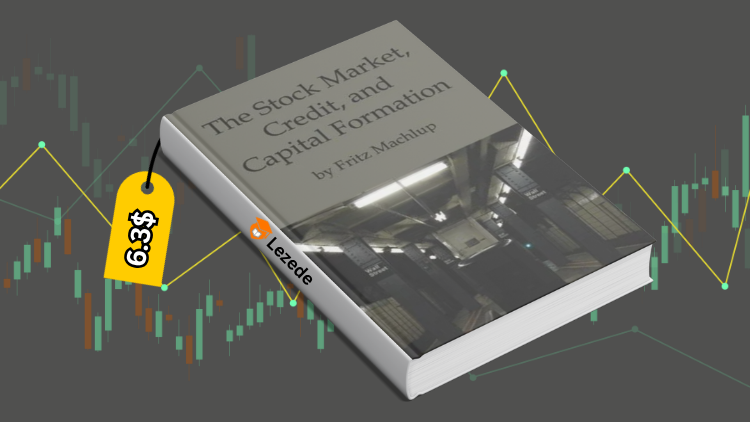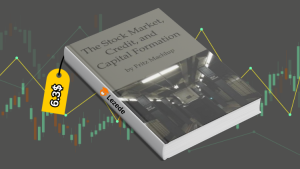Free Download The Stock Market, Credit & Capital Formation by Fritz Machlup
Check content proof, now:
Fritz Machlup’s Analysis of the Stock Market, Credit, and Capital Formation
Fritz Machlup made a substantial contribution to financial economics and the Austrian school of thought with his seminal work, The Stock Market, Credit & Capital Formation. Written in German and first published in 1930, the English edition was released ten years later with significant changes. The intricate relationship between rising credit, monetary policy, and stock prices is examined in detail in this study, which also explains how these factors work together to affect capital formation and economic stability. Machlup’s views are still very relevant today, offering important insights into the workings of the financial markets and current economic issues.
Understanding the Business Cycle from the Point of View of Austria
The Austrian school’s emphasis on the business cycle forms the foundation of Machlup’s research. He thoroughly examines the ways in which changes in loan availability might set off cyclical economic patterns. Machlup demonstrates how credit growth usually comes before periods of economic boom, encouraging increased investment and capital accumulation, by looking at historical data and economic trends. Unchecked expansion has the potential to cause economic instability, which could lead to market distortions and subsequent financial downturns.
The Connection Between Investment and Credit
The mechanism by which credit growth encourages investment is one of Machlup’s main points. According to him, having access to finance lowers borrowing costs, which encourages companies to launch new projects and grow. This investment infusion has the potential to start a positive feedback loop by stimulating economic growth. Machlup warns that overextending credit could lead to overinvestment and asset bubbles, especially in the stock market. His research highlights how important a balanced monetary policy is to preserving long-term economic stability.
Empirical Findings and Their Current Importance
Machlup’s research is backed by extensive empirical evidence and is not just theoretical. He establishes a connection between credit policies and their tangible effects on financial stability. Machlup cites earlier instances in which abrupt credit restrictions caused notable market and economic downturns. Since contemporary economists continue to discuss the effects of loose monetary policy and how they affect the dynamics of financial markets, these observations are still highly pertinent today. Machlup’s theories provide a basic understanding that aids in deciphering the complex connection between credit systems and economic outcomes.
Economic Cycles and Stock Market Dynamics
Machlup’s perceptive examination of stock market dynamics in relation to larger economic cycles is a noteworthy feature of his research. He explains how changes in the business cycle can have a significant impact on stock market movements, often in unpredictable ways. Machlup’s research on stock market bubbles is important because he describes the conditions that allow speculative investments to thrive and ultimately fail, escalating economic instability.
The Function of Monetary Policy in Equity Valuations
Machlup asserts that monetary policy is essential in influencing stock valuations. When credit is plentiful, investors are more predisposed to acquire equities, resulting in increased prices. Conversely, the constriction of credit may precipitate sell-offs, as enterprises and consumers reduce investments and expenditures. The cyclical nature of stock prices, influenced by fluctuating credit circumstances, highlights the complex balance necessary in monetary policy to avert severe market volatility and maintain economic stability.
| Credit Conditions | Stock Market Impact | Economic Outcome |
| Expanding Credit | Rising stock prices | Increased investment |
| Tightening Credit | Falling stock prices | Reduced spending |
| Stable Credit | Moderate market growth | Economic stability |
Table 1: Impact of Credit Conditions on Stock Market and Economic Outcomes
Comparative Analysis with Contemporary Markets
Comparing Machlup’s theories with today’s financial landscapes reveals striking similarities. The 2008 financial crisis, for example, can be partly attributed to unchecked credit expansion and ensuing stock market bubbles, echoing Machlup’s warnings. Similarly, the recent surge in credit availability through low-interest rates has reignited debates on potential market overheating and the risk of future economic contractions. Machlup’s framework provides a robust tool for analyzing these modern phenomena, reinforcing the timelessness of his economic insights.
Credit Expansion and Market Distortions
Machlup emphasizes that while credit expansion can stimulate economic activity, it also harbors the potential to create significant market distortions. These distortions manifest in various forms, including inflated asset prices, misallocation of resources, and increased financial vulnerability. Machlup’s nuanced view highlights that moderate credit growth is beneficial, but excessive or poorly managed credit can lead to economic instability and financial crises.
Mechanisms of Market Distortion
The primary mechanism through which credit expansion distorts markets is the creation of artificial demand for assets. As credit becomes more accessible, investors pour money into high-risk ventures, inflating prices beyond their intrinsic values. This scenario often leads to speculative bubbles, where the disconnect between asset prices and their fundamental worth widens. When the bubble bursts, it results in sharp price declines, eroding investor confidence and precipitating broader economic contractions.
Preventive Measures and Policy Recommendations
To mitigate the risks associated with credit-induced market distortions, Machlup advocates for prudent monetary policies and robust regulatory frameworks. He suggests that central banks should carefully monitor credit growth and implement measures to prevent excessive borrowing and speculative investments. Additionally, fostering transparency and accountability within financial markets can help identify and address potential imbalances before they escalate into full-blown crises.
Accumulation of Capital and Economic Balance
The idea of capital production, which Machlup views as a crucial driver of economic growth and stability, lies at the heart of his argument. The process of increasing a country’s capital stock through investments in machinery, infrastructure, and other productive assets is known as capital creation. Effective capital creation, according to Machlup, is essential to sustaining long-term economic growth because it boosts productivity, encourages innovation, and creates job opportunities.
The Connection Between Credit and Capital Formation
In his analysis of the interconnectedness of credit and capital creation, Machlup makes the case that credit is a crucial catalyst for capital goods investment. However, he also cautions that credit quality is a significant factor. While prudent, purpose-driven finance can support large capital investments, speculative or indiscriminate lending can result in wasteful spending and ineffective capital allocation. This distinction emphasizes the need for targeted lending practices that prioritize projects with real economic value.
Case Studies and Their Useful Implications
Machlup illustrates how effective credit management has made significant capital development and economic resilience possible through the examination of past case studies. On the other hand, examples of poorly controlled credit growth, such as speculative boom-bust cycles, highlight the detrimental effects of market distortions on capital formation. For contemporary financial institutions and governments looking to support sustainable economic development, these examples provide useful insights.
Modern Significance and Empirical Evidence
Machlup’s study is distinguished by its empirical accuracy, which combines theoretical viewpoints with real-world results. He thoroughly investigates historical data to support his assertions, demonstrating a deep understanding of the real effects of credit laws and financial market structures. The validity and applicability of his theories are supported by this empirical foundation, making The Stock Market, Credit & Capital Formation a timeless resource for financial experts and economists.
Significance in the Contemporary Economic Environment
In the contemporary intricate and interlinked global economy, Machlup’s observations are increasingly pertinent. The difficulties presented by low-interest rates, quantitative easing, and global financial integration reflect the dynamics that Machlup examined decades prior. Contemporary economists can derive significant insights from his work to navigate the intricate balance between credit expansion and economic stability, ensuring that capital development favorably influences long-term growth.
| Contemporary Economic Issues | Machlup’s Insights | Implications |
| Low-Interest Rates | Caution against excessive credit expansion | Need for balanced monetary policies |
| Quantitative Easing | Potential for asset price inflation | Monitoring and regulating financial markets |
| Global Financial Integration | Interconnectedness of credit systems | Coordinated international economic policies |
Table 2: Application of Machlup’s Insights to Contemporary Economic Issues
Ongoing Academic and Practical Impact
Machlup’s theories continue to influence both academic discourse and practical policy-making. His emphasis on the role of credit in shaping economic outcomes has inspired numerous studies and policy frameworks aimed at enhancing financial stability. Furthermore, his work serves as a foundation for understanding market behaviors, guiding financial institutions in their risk assessment and investment strategies.
Conclusion
Fritz Machlup’s The Stock Market, Credit & Capital Formation remains an indispensable work in the field of financial economics. By dissecting the complex relationships between credit expansion, monetary policy, and stock market dynamics, Machlup provides a comprehensive framework for understanding economic cycles and capital formation. His blend of theoretical acumen and empirical analysis offers timeless insights that continue to resonate in contemporary economic discussions. For scholars, policymakers, and financial professionals alike, Machlup’s work is a vital resource for navigating the intricacies of financial markets and fostering sustainable economic growth.












